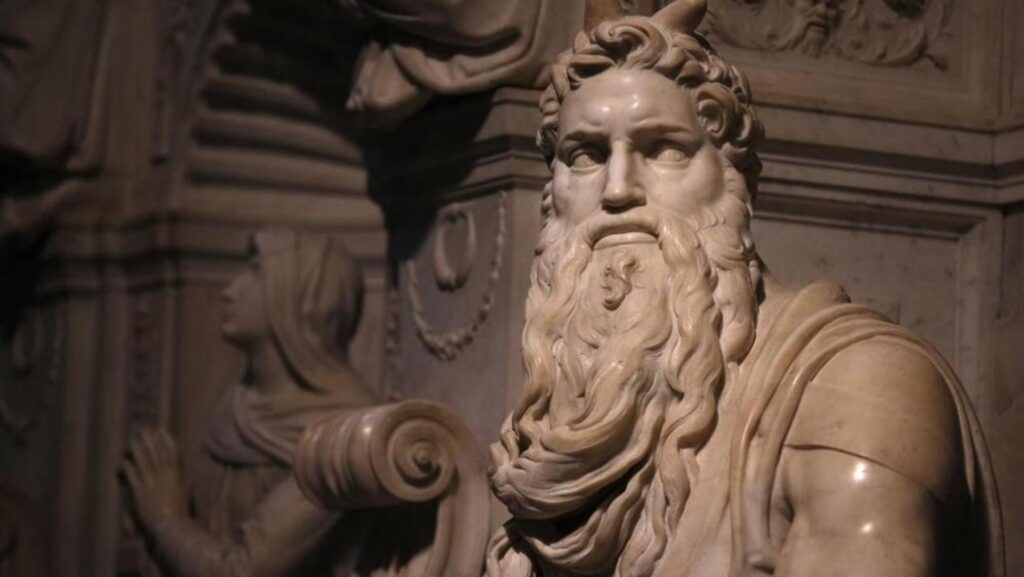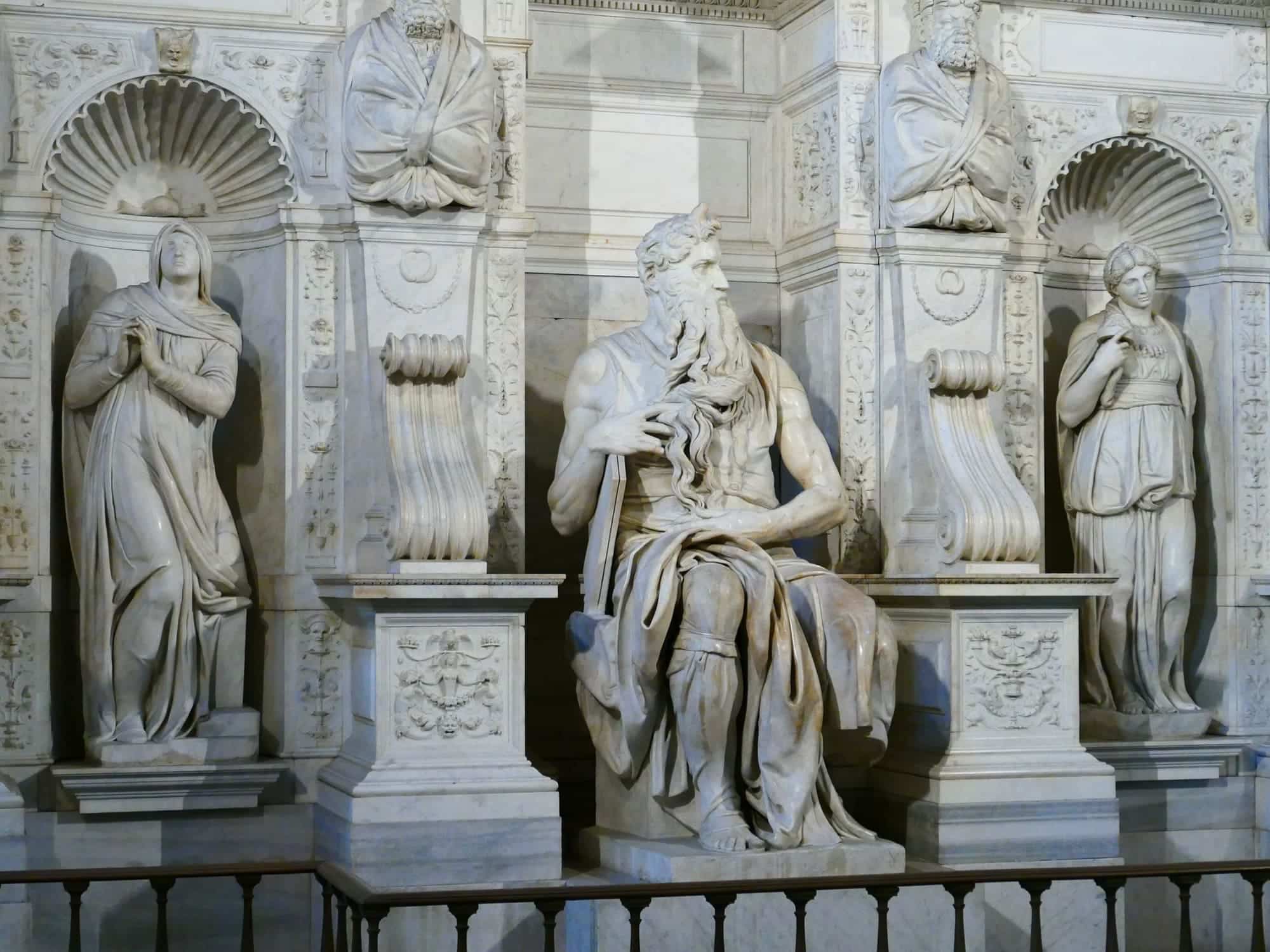Michelangelo’s Moses is one of the most striking works of art of the Italian Renaissance. Carved in Carrara marble between 1513 and 1515, during the 16th century, this work of art depicts the prophet Moses with a physical and spiritual strength that continues to amaze historians, artists and visitors from all over the
world.
Located in the church of San Pietro in Vincoli in Rome, the sculpture of Moses was to be part of the ambitious mausoleum of Pope Julius II. Although the original project underwent many changes, the Moses ended up becoming the central and most iconic figure of the ensemble. Its penetrating gaze, the tension of the muscles and the symbolic richness of every detail place it among the summits of sculptural art.
A Renaissance sculpture with a soul of its own
Michelangelo Buonarroti created the Moses at a stage of full artistic maturity, after having created other works of art such as the Pietà and Michelangelo’s David, with which he had already achieved international fame. At this point in his career, the Florentine sculptor had mastered both technique and the ability to convey complex emotions through marble. As a leading figure of the Italian Renaissance, his style combined anatomical perfection with deep symbolism and a narrative intent charged with meaning.
The Moses reflects that perfect balance between form and emotion. The sculpture shows the prophet seated, but with a posture that suggests imminent movement. The twisting of the trunk, the head turned with intensity and the tension accumulated in the legs indicate that he is about to stand up. This gesture, apparently contained, transmits the latent energy of the character, as if he were about to intervene with divine authority in the face of the betrayal of his people.
Michelangelo succeeds in sculpting the human figure with an astonishing level of realism: every muscle is defined, every tendon stretched at the precise moment. However, what makes this figure special is not only its physical accuracy, but the psychological depth that emanates from Moses’ face. His expression mixes anger, pain, reflection and restraint. It is the portrait of a spiritual leader facing disappointment, but still mastering his impulses in the name of a higher cause.
The beard, long and meticulously carved, blends with the folds of the robe in a masterly manner, demonstrating an unprecedented technical virtuosity. The details of the hands – one holding the Tablets of the Law, i.e., the Ten Commandments, and the other pressing the leg – reinforce that emotional tension. The robe falls in deep, natural folds, reinforcing the dynamism of the scene.
This Moses is neither a passive figure nor a static portrait. It is a living sculpture, with a soul of its own. A work that embodies the spirit of the Renaissance: the mastery of technique, the recovery of classical values and, above all, the profound exploration of the human being and his inner world.

The meaning of Michelangelo’s Moses
The sculpture represents the moment when Moses descends from Mount Sinai carrying the Ten Commandments and discovers that his people have fallen into idolatry. The intensity of his expression is related to that moment of divine anger, although contained by the will of the prophet. This duality is key to understanding the sculpture.
One of the most commented characteristics is the presence of two horns on Moses’ head. This representation comes from an erroneous translation from Hebrew to Latin in the Vulgate, where the word “keren” (ray of light) was interpreted as “horn”. Michelangelo, faithful to the sacred texts of his time, included these elements that today generate debate among historians and theologians.
How the Moses was sculpted: technique and materials
The Moses was carved in white Carrara marble, considered the noblest material of the Renaissance for its purity, density and ease of polishing. Michelangelo personally chose the blocks, always seeking perfection in order to liberate the figure that, according to him, already lived inside the stone.
In this sculpture, every muscle, every fold of the tunic and every strand of the beard was worked with admirable precision. The artist used hand tools such as pointers, chisels, chisels, gradinas and natural abrasives to achieve a detailed and expressive modeling.
The polished surface allows the light to glide softly over the volumes, generating subtle shadows that accentuate the tension of the body. Thanks to the quality of the marble and the good state of conservation, the work maintains its visual strength intact more than five centuries after its creation. It is a figure of more than two meters high, conceived to stand out within the monumental mausoleum of Julius II.

Influence and cultural impact of Michelangelo’s Moses.
Michelangelo’s sculpture of the Moses has left a profound mark on the history of art. Since its creation, it has been recognized as a masterpiece, and its impact has grown over the centuries. Later artists such as Gian Lorenzo Bernini in the Baroque or Auguste Rodin in the 19th century found in it a source of inspiration for its dramatic force and restrained expressiveness. Both recognized in the Moses an emotional intensity difficult to match.
Rodin, considered the father of modern sculpture, shared Michelangelo’s obsession with conveying emotions through form. His work The Thinker reflects that same introspection and restrained tension that makes the sculpture of the prophet so powerful.
On an intellectual level, the Moses has been the subject of numerous interpretations. One of the most prominent is Sigmund Freud’s essay entitled Michelangelo’s Moses, where the father of psychoanalysis analyzes the figure’s posture as a symbol of the ego’s mastery over impulses. For Freud, Moses does not burst out in anger, but rather represses it, showing a form of mature and spiritual wisdom.
In addition to its artistic and philosophical influence, the Moses has transcended popular culture. It has been reproduced in prints, photographs, books and digital media from the eighteenth century to the twentieth century, establishing itself as an iconic image of Renaissance art and the genius of Michelangelo. Its aesthetics also hark back to the grandeur of classical antiquity, which so influenced Renaissance art.
A must for art lovers
Visitors to San Pietro in Vincoli are impressed by the monumentality of the sculpture and the energy it transmits. Although the church is home to other works of interest, the Moses is the center of attention. His presence fills the space with a silent authority, as if waiting for the moment to rise and act.
At Capa Esculturas, we understand the power of marble as a means of artistic expression. Just as artists from the 4th to the 20th century left their mark through their sculptures, we are also inspired by the continuity of figurative art. Works such as Michelangelo’s Moses encourage us to keep the sculptural tradition alive, combining classical techniques with current technologies. Each sculpture we create reflects our respect for the great masters of the Renaissance and our commitment to artistic excellence.
If you are passionate about figurative sculpture or you are looking for a custom sculpture, we invite you to discover how we work in our workshop. You can also explore our completed projects and learn more about the fusion between classical art and contemporary creation.

